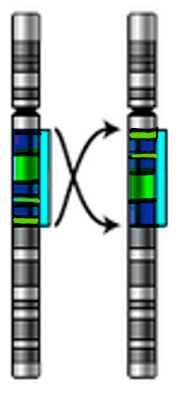Reason for trisomy in Down's syndrome is:
1. Non-disjunction during sperm formation
2. Non-disjunction during egg formation
3. Non-disjunction at the time of egg or sperm formation
4. Addition of one extra chromosome during mitosis

To unlock all the explanations of 38 chapters you need to be enrolled in MasterClass Course.

To unlock all the explanations of 38 chapters you need to be enrolled in MasterClass Course.
The chromosomal aberration ‘duplication’ is best described as:
1. The presence of an extra copy of an existing chromosome.
2. The presence of an entirely new piece of chromosomal material.
3. The presence of an extra copy of a piece of chromosomal material.
4. The result of chromosomal material exchanged between two chromosomes.
What would be true for an allotetraploid species:
I: It contains a complex diploid set from each parent
II: It can produce viable gametes
III: It may be important in agriculture
1. I & II only
2. I & III only
3. II & III only
4. I, II & III
Gross large chromosomal aberrations can be rapidly identified by
1. Karyotype analysis.
2. Genetic studies.
3. Pedigree analysis.
4. DNA fingerprinting
An abnormal human baby with 'XXX' sex chromosomes was born due to :
1. formation of abnormal ova in the mother
2. fusion of two ova and one sperm
3. fusion of two sperms and one ovum
4. formation of abnormal sperms in the father
Identify the condition where the following karyotype is expected:

1. Klinefelter’s syndrome
2. Cri du chat syndrome
3. Turner’s syndrome
4. Down’s syndrome

To unlock all the explanations of 38 chapters you need to be enrolled in MasterClass Course.

To unlock all the explanations of 38 chapters you need to be enrolled in MasterClass Course.
Identify the chromosomal aberration:

1. Inversion
2. Translocation
3. Deletion
4. Duplication
Cri-du-chat syndrome in humans is caused by
1. Trisomy of 21st chromosome
2. Loss of half of short arm of chromosome 5
3. Loss of half of long arm of chromosome 5
4. Fertilization of an XX egg by a normal Y- bearing sperm.
A primary non-disjunction event involving an autosome may lead to:
1. Down’s Syndrome
2. Klinefelter’s syndrome
3. Turner’s syndrome
4. Cushing’s syndrome
A cell at the telophase stage is observed by a student in a brought from the field. He tells his teacher that this cell is not like other cells at the telophase stage. There is no formation of a cell plate and thus the cell is containing more chromosomes as compared to other dividing cells. This would result in:
1. polyploidy
2. somaclonal variation
3. polyteny
4. aneuploidy

To unlock all the explanations of 38 chapters you need to be enrolled in MasterClass Course.

To unlock all the explanations of 38 chapters you need to be enrolled in MasterClass Course.


